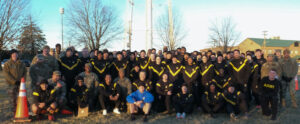
Story by C.J. Lovelace
U.S. Army Medical Logistics Command
FORT DETRICK, Md. — U.S. Army Medical Logistics Command joined the Army Medical Department in celebrating the Enlisted Medical Corps’ 137th birthday on March 1.
Headquarters staff members of AMLC and its direct reporting unit, the U.S. Army Medical Materiel Agency, took part in an early-morning PT session and fitness challenge event to mark the occasion at Fort Detrick. The installation also hosted a ceremony on post to recognize enlisted leaders.
Founded in 1887, AMEDD’s enlisted corps began with just eight military occupational specialties, or MOS. Today, it’s expanded to 24, with 12 additional skill identifiers, making it one of the most diverse and complex corps in the Army.
“These Soldiers are charged not only with defending our nation, but also facilitating an entire spectrum of health care operations, from logistics to patient care and health support administration,” AMLC Command Sgt. Maj. Gabriel Wright said. “They are, without a doubt, the backbone of Army Medicine.”
On the logistics side of the house, AMLC and its three direct reporting units have numerous current and former members of the enlisted corps within its ranks, including biomedical equipment specialists, medical logistics specialists, combat medics and more.
Master Sgt. William Harbeson joined the Army in 2007, although he admits he initially considered going Air Force. Ultimately, he chose the Army to pursue a career as a biomedical equipment specialist, or 68A.
“I’ve always been mechanically inclined and I liked tinkering with things,” he said. “I just kind of had a knack for it and I knew it would be a good career.”
Harbeson, who currently serves as noncommissioned officer in charge for AMLC’s assistant chief of staff for support, said he’s “always worked hard and never complained,” which helped him advance in his career field.
After moving up from his first duty station in Germany, Harbeson joined the contact repair team for Europe, a role that sent him down range to service high-tech imaging equipment and assist other BMETs on the ground in deployed settings, including in Afghanistan.
Harbeson said it was there that he really saw the true impact of his work, in that Army medicine had become increasingly dependent on high-tech equipment that needed expert-level repair technicians to service. 68As are vital to ensuring medical devices are maintained, calibrated and operating within standards, which can mean life or death for a Soldier or a family member.
“I think that’s how we impact the warfighter,” he said.
Sgt. 1st Class Adrian Doll works as an operations NCO at the U.S. Army Medical Materiel Agency, an AMLC direct reporting unit. It’s his first role in a command-level position, having served his first nine years in brigade combat teams as a combat medic, or 68W.
After experiencing what it’s like for USAMMA’s end users on the battlefield, Doll said it’s given him valuable perspective to continue supporting the warfighter in his current role.
The Enlisted Medical Corps is “extremely important” to the overall operation of the AMEDD, Doll added, saying the 68-series Soldiers are “really where the rubber meets the road.”
“We are the ones taking action,” he said. “We are the ones who are making sure those troops at the individual level are trained and ready to go.”
Another integral member of the system are the medical logistics specialists, or 68Js, like Staff Sgt. Tereso Hernandez.
Hernandez has served as a “Juliet” for his entire 17-year career. It’s a profession that has allowed him to be a “jack of all trades” when it comes to MEDLOG.
“We specialize in all things medical logistics supply, parts, but also working hand in hand with the Whiskeys, the Alphas,” he said.
Now working at USAMMA headquarters, Hernandez serves as a supply NCO. It’s allowed him to round out his skill set to include more strategic level experience.
“But there are times when I do miss being out there, doing the legwork, moving the pieces around,” he said. “Being a part of that, it really has shed new light on what my service and what I’ve been doing really means to me.”
Looking back on the history and mission of the AMEDD over the years, Wright said it’s important to remember how the enlisted role has evolved, starting out as hospital stewards to support caregivers to now serving as subject-matter experts in areas like occupational therapy, radiology, dental, pharmacy and more.
“Anywhere the Army provides health care, you’ll find members of our enlisted corps,” he said. “As we celebrate our birthday, the AMLC command team recognizes and thanks these dedicated professionals, who mean so much to our collective mission to support the health and wellbeing of Soldiers and families around the world.”